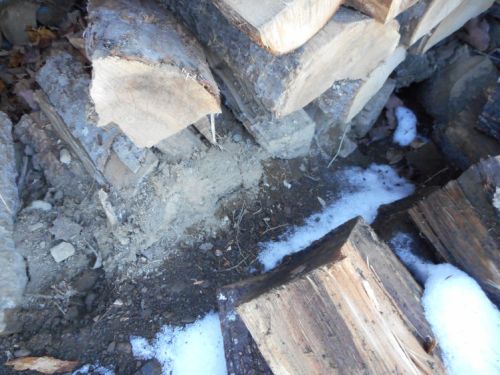[Updated 30-Dec 2019]
Omen Days [ 1 | 2 | 3 | 4 | 5-6 | 7-9 | 10-11 | 12-13 ]
Groundhog, whistle-pig, moonack (derived from a Native American name), or French Canadian siffleux (“whistler”) — as I take more firewood from the stack, I’ve found our backyard woodchuck has again taken shelter for the winter in a burrow between our woodpile rows. It makes good animal sense: until I started taking the wood away for fires, the burrow mouth was protected, and tin sheets still partially shield both wood and burrow from snow and rain.

woodchuck — marmota monax — Wikipedia
The woodchuck enjoys a regional claim-to-fame in the U.S. as “Punxsatawney Phil” and indeed has a brief cameo in the ’93 Bill Murray/Andie MacDowell comedy, Groundhog Day.
(We can detect in the February 2 Groundhog Day — no surprise — echoes of older celebrations like Imbolc. The harsher winters in North America merely postpone the coming of spring that the European holiday anticipates, until late March at the earliest, at least in New England. Animal divination!! The groundhog’s “prediction” of early spring or more winter depends, after all, on sunlight: if it’s sunny and he sees his shadow — only his “priests” know for sure — that means, paradoxically, six more weeks of winter.)
When our next-door neighbor dug a new in-ground septic tank over a year ago, things reached a tipping point that made “his” marmota monax leave home in search of a better life. The journey didn’t demand much — no long treks for the plucky immigrant who would ultimately set down roots in a strange new land. Instead, just a quick run under the property line fence, and voila! Our handy clover patch no doubt also played a savory role — we saw him — them? — off and on this past summer in the thick of it, grazing quite contentedly, bees humming all around in the clover flowers.
Last winter I discovered him burrowed in under the first row of the woodpile. By the time spring came, and I’d cleared away the logs and knew he was out, I drove a log firmly into the mouth of the burrow. (I absolutely refuse to use the smoke bombs that poison both animal and soil. Have-a-heart traps may be the next option.) Sure enough, un-dissuaded, he dug a new hole in June, this time right along the east-facing foundation of our house. When I stuffed a log into the mouth of that hole, he dug around it. I added another log. Then when I didn’t see him for a while, I thought my harassment campaign had paid off, and maybe he’d finally crossed the road, where there’s some prime woodchuck real estate that could be his for the taking. A neighboring farmer mows the open, level 5-acre meadow bordered by woods just once a summer, and otherwise it lies fallow, undisturbed.

Hard to see, but dirt between the log rows comes from the enlarged burrow
But there’s the roof of his winter burrow, with its mouth one row deeper into the woodpile. Part of me rejoices at his resilience, even as I plan anew how to see him off, once warmer weather arrives. All this, of course, while another part of me ponders whether this is indeed the unsubtle arrival of a new animal guide, upping his campaign to grab the attention of this torpid and obtuse human.
In the guise of a woodchuck, a delightful link exists between Frost and Thoreau, those two quintessential New England bards. A wry Colby Quarterly article, “Two Woodchucks, or Frost and Thoreau and the Art of the Burrow” , exhibits good Druidic sensibility in exploring that link. Regardless of whether the article author actually follows through on his own insights, they remain for readers. To make a cellar for his cabin at Walden Pond, Thoreau enlarged a woodchuck’s burrow, trusting the beast had dug deep enough, beneath the frost line. Here the “Two Woodchucks” author cites Thoreau’s sense of the need to dig down both literally and metaphorically to find out the truth of things:
In order to find this reality, we must first “settle ourselves,” establish a sense of place, a living connection with the landscape. Then we must “work and wedge our feet downward,” in woodchuck fashion, “through the mud and slush of opinion, and prejudice, and tradition, and delusion, and appearance, that alluvion [alluvium] which covers the globe”.
I read as I draft this post that the woodchuck can nearly double its weight as it gorges each autumn to store up fat for hibernation. The average burrow, with between two and eight mouths, requires the removal of 500 lbs / 225 kilos of dirt. Sure enough, it often digs a separate winter burrow, much deeper than its summer quarters. Though at need the woodchuck can climb trees to escape predators, and typically retreats to its burrow rather than fight, when cornered, the sturdy beast has claws and sharp incisors to defend itself. Their range spans from Georgia to Minnesota and New England, north as far as Newfoundland, and west across the Canadian plains into Alaska. Study almost any creature, and you begin to see its adaptations to its specific life-path emerging as something quite remarkable.
Boar, pillbug, woodchuck — the teachings of animal encounters to guide this Druid, if he only listens, through his days.
/|\ /|\ /|\
